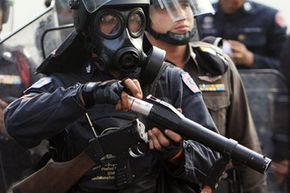Methods of Dispersal
Interestingly enough, the star ingredient of tear gas, orthochlorobenzalmalononitrile (CS), is actually a solid powder. In order to disperse this tear-jerker as a gas, chemists require the help of a dispersal agent, such as the solvent methylene chloride, which carries the particles through the air. A typical tear gas grenade contains a host of additional chemicals for heat dispersal of the irritant. When the solid CS powder heats up, it vaporizes into an easily dispersed aerosol.
Methods of tear gas dispersal vary, but the irritant usually scatters into crowds as a component of an aerosol solution, explosive device or smoke. In addition to hand-thrown grenades and canisters, military and police forces also use tear gas mortars and projectiles for use in riot guns, alongside such ordnance as rubber bullets. Aircraft and vehicle dispersal devices have also seen action, as have personal ones such as hand-held sprays and even gas-emitting batons.
Advertisement
The dispersal method itself can prove dangerous, however, as illustrated in 2011 when a police tear gas canister fractured the skull of protester and Iraq war veteran Scott Olsen [source: McKinley].
CS gas rapidly loses its effectiveness in a given environment -- especially in the open air. To counteract this property, the U.S. Department of Defense has created at least three different CS variants [source: Lenhart]:
- CS1: This variant consists of 95 percent CS and 5 percent silica aerogel (a low-density synthetic material) to prevent CS particles from clustering together.
- CS2: Designed to float on water, resist degradation and boast a longer shelf life, CS2 is 94 percent CS, 5 percent colloidal silica (a material related to silica aerogel) and 1 percent hexamethyldisilizane (a solvent).
- CSX: This liquefiable CS variant consists of 1 percent CS1 and 99 percent trioctylphosphite (a stabilizing agent).
What should you do when you encounter tear gas? How can you prepare for scenarios where it might be deployed? Skip to the next page to find out.
